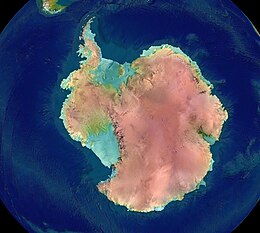 | |
| Continent | Antarctica |
|---|---|
| Coordinates | 80°S 90°E / 80°S 90°E |
| Area | Ranked 2nd (unofficially) |
| • Total | 14,200,000 km2 (5,500,000 sq mi) |
| • Land | 98% |
| • Water | 2% |
| Coastline | 17,968 km (11,165 mi) |
| Borders | None |
| Highest point | Vinson Massif, 4,897 m (16,066 ft) |
| Lowest point | Bentley Subglacial Trench, −2,555 m (−8,382.5 ft) |
| Longest river | Onyx River, 32 km |
| Largest lake | Lake Vostok, 26,000 sq m (est.) |
| Climate | subantarctic to antarctic |
| Terrain | ice and barren rock |
| Natural resources | krill, fin fish, crab |
| Natural hazards | high winds, blizzards, cyclonic storms, volcanism |
| Environmental issues | depleting ozone layer, rising sea level |
The geography of Antarctica is dominated by its south polar location and, thus, by ice. The Antarctic continent, located in the Earth's southern hemisphere, is centered asymmetrically around the South Pole and largely south of the Antarctic Circle. It is washed by the Southern (or Antarctic) Ocean or, depending on definition, the southern Pacific, Atlantic, and Indian Oceans. It has an area of more than 14.2 million km2. Antarctica is the largest ice desert in the world.
Some 98% of Antarctica is covered by the Antarctic ice sheet, the world's largest ice sheet and also its largest reservoir of fresh water. Averaging at least 1.6 km thick, the ice is so massive that it has depressed the continental bedrock in some areas more than 2.5 km below sea level; subglacial lakes of liquid water also occur (e.g., Lake Vostok). Ice shelves and rises populate the ice sheet on the periphery. The present Antarctic ice sheet accounts for 90 percent of Earth's total ice volume and 70 percent of its fresh water. It houses enough water to raise global sea level by 200 ft.
In September 2018, researchers at the National Geospatial-Intelligence Agency released a high resolution terrain map (detail down to the size of a car, and less in some areas) of Antarctica, named the "Reference Elevation Model of Antarctica" (REMA).[1]
- ^ Stirone, Shannon (7 September 2018). "New Antarctica Map Is Like 'Putting on Glasses for the First Time and Seeing 20/20' – A high resolution terrain map of Earth's frozen continent will help researchers better track changes on the ice as the planet warms". The New York Times. Retrieved 9 September 2018.